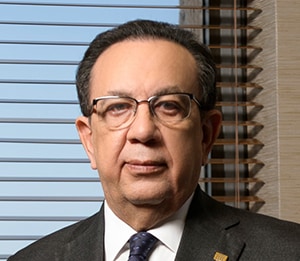Héctor Valdez Albizu, governor of the Central Bank of the Dominican Republic, on economic prospects and efforts to attract investors.
Global Finance: What are the economic prospects for the Dominican Republic for the rest of the year and 2020?

Héctor Valdez Albizu: The perspectives of the Dominican Republic [DR], based on the monetary program, envisage that by 2019 the economy could grow around its potential. However, this economic growth can be affected by uncertainty at the international level—associated with trade disputes between larger economies and geopolitical conflicts that have weakened global growth prospects—as well as by domestic factors, like the electoral cycle in our country. An important element that might contribute to the expected economic growth is the easing of monetary policy in advanced and emerging economies, including the DR, which could help attain more favorable financial conditions. In turn, the recent evolution of oil and gold prices has led to an improvement in the terms of trade for the DR that will contribute to the performance of the export sector.
In this context, the growth of the economy has gradually moderated this year, displaying 4.7% growth during the first half. In June, in an environment of uncertainty, the slowdown in economic activity and the absence of inflationary pressures allowed the central bank to implement expansive monetary-policy measures. These measures included a reduction of 75 basis points in the monetary policy rate, as well as the release of more than 34 billion Dominican pesos [$662 million] of legal reserve requirement funds to be channeled as loans for the [most] productive sectors.
These measures have begun to boost private credit and improve monetary conditions, and are expected to stimulate domestic demand through increased private consumption and investment during the second half of the year. In that sense, the projections indicate that by the end of 2019, economic growth would reach its potential between 5% and 5.5% and would converge at 5% by 2020. On the other hand, inflation is likely to remain low during 2019, closing the year around the lower limit of the target of 4%, plus or minus 1%, and gradually approaching the core value of the target range for the year 2020.
GF: What is the country doing to attract foreign investment?
Valdez Albizu: Strong macroeconomic foundations and stability are the main attractions of the Dominican economy for foreign investors. In fact, the DR will maintain the highest growth levels in Latin America, while inflation will remain low and stable. Additionally, there has been a significant reduction of the twin deficits—that is, in the fiscal and current account balances—in an environment of relatively stable exchange rates. This has resulted in a significant increase in international reserves and higher confidence among international investors, reflected in the reduction of sovereign risk indicators and upward revisions by rating agencies.
Excluding Panama, the DR is the main recipient of investment in Central America and the Caribbean. In addition to macroeconomic stability, the country offers an unbeatable geographical position, favorable business climate and regulations to encourage investment, export-free zones, real estate, renewable energy, cinema and manufacturing, among others.
In addition, in recent years, multilateral and bilateral relations have strengthened–mainly the agreements with our main trading partner, the United States, as well as with the European Union. Moreover, trade relations were established with China at the end of 2018, which will contribute to increased foreign investment, trade and tourism from the Asian giant.
GF: What keeps you awake at night? What are the main risks?
Valdez Albizu: We currently face a complex international environment, with a general slowdown in both advanced and emerging economies. Lack of resolution of commercial disputes, increasing geopolitical tensions and the possibility of a no-deal Brexit constitute the main elements of risk on an international level. On the domestic front, the risks relate to the uncertainty that characterizes pre-electoral processes, as well as the permanent risk of extreme climatic events such as droughts, floods and storms.
However, the solid foundations of the Dominican economy and the low inflationary pressures give monetary policymakers enough room to react in a timely manner and evaluate any external and domestic shocks that may put macroeconomic stability at risk. The Central Bank of the Dominican Republic currently implements a set of expansive monetary measures with the objective of boosting private credit and aggregate demand, thus contributing to improved performance in the [most] productive sectors and sustained economic growth.



